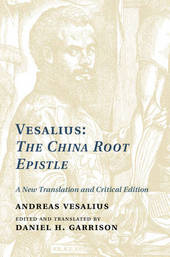
|
Vesalius: The China Root Epistle: A New Translation and Critical Edition
Hardback
Main Details
| Title |
Vesalius: The China Root Epistle: A New Translation and Critical Edition
|
| Authors and Contributors |
By (author) Andreas Vesalius
|
|
Edited and translated by Daniel H. Garrison
|
| Physical Properties |
| Format:Hardback | | Pages:290 | | Dimensions(mm): Height 235,Width 158 |
|
| Category/Genre | Anatomy
History of science |
|---|
| ISBN/Barcode |
9781107026353
|
| Classifications | Dewey:611.009031 611 |
|---|
| Audience | | Professional & Vocational | |
|---|
| Illustrations |
37 Line drawings, unspecified
|
|
Publishing Details |
| Publisher |
Cambridge University Press
|
| Imprint |
Cambridge University Press
|
| Publication Date |
12 January 2015 |
| Publication Country |
United Kingdom
|
Description
This book provides the first annotated English translation from the original Latin of Andreas Vesalius' China Root Epistle. Ostensibly his appraisal of a fashionable herbal remedy, the China Root Epistle concentrates on Vesalius' skeptical appraisal of traditional Galenic anatomy, which was based on animal rather than human dissections. Along with reflections about his life as a young anatomist, Vesalius argued that the new science of anatomy should devote itself less to rhetorical polemics and more to the craft of direct observation based on human dissection. This volume provides annotations to link the Epistle with Vesalius' earlier and more famous work, On the Fabric of the Human Body, and includes illustrations from the famous woodcuts first used in the 1543 edition of the Fabrica.
Author Biography
Daniel H. Garrison is Professor Emeritus in the Department of Classics at Northwestern University. He is the translator of The Fabric of the Human Body (with Malcolm Hast, forthcoming) and the author of several books, including Sexual Culture in Ancient Greece, The Student's Catullus and Horace Epodes and Odes. A New Annotated Latin Edition.
Reviews'Non-Latin readers can now compare its contentwith the annotations in Vesalius's own hand to the revised Fabrica of 1555, viewed as a major contribution to anatomical understanding in its own right rather than a mere update of 1543.' Gul Russell, Renaissance Quarterly
|